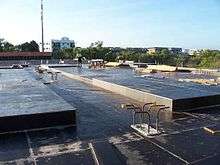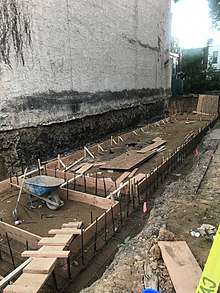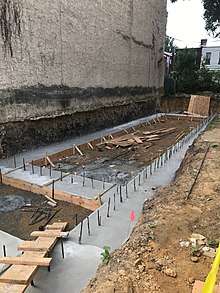Concrete slab


A concrete slab is a common structural element of modern buildings. Horizontal slabs of steel reinforced concrete, typically between 4 and 20 inches (100 and 500 millimeters) thick, are most often used to construct floors and ceilings, while thinner slabs are also used for exterior paving. Sometimes these thinner slabs, ranging from 2 inches (51 mm) to 6 inches (150 mm) thick, are called mud slabs, particularly when used under the main floor slabs[1] or in crawl spaces.[2]
In many domestic and industrial buildings a thick concrete slab, supported on foundations or directly on the subsoil, is used to construct the ground floor of a building. These can either be "ground-bearing" or "suspended" slabs. The slab is "ground-bearing" if it rests directly on the foundation, otherwise the slab is "suspended".[3] For double-storey or multi-storey buildings, the use of a few common types of concrete suspended slabs are used (for more types refer to the Concrete Slab#Design section below):
- Beam and block also referred to as Rib and Block, are mostly used in residential and industrial applications. This slab type is made up of pre-stressed beams and hollow blocks and are temporarily propped until set, typically after 21 days.
- A Hollow core slab which are precast and installed on site with a crane.
- In high rise buildings and skyscrapers, thinner, pre-cast concrete slabs are slung between the steel frames to form the floors and ceilings on each level. Cast in-situ slabs are used in high rise buildings and huge shopping complexes as well as houses. These in-situ slabs are cast on site using shutters and reinforced steel.
On the technical drawings, reinforced concrete slabs are often abbreviated to "r.c.c.slab" or simply "r.c.". Technical drawings are often created by structural engineers who use software such as AutoCad or Revit structure.
Thermal performance
There are two main thermal considerations. The first is the question of insulating a floor slab. In older buildings, concrete slabs cast directly on the ground can drain heat from a room. In modern construction, concrete slabs are usually cast above a layer of insulation such as expanded polystyrene, and the slab may contain underfloor heating pipes. However, there are still uses for a slab that is not insulated, typically in outbuildings which are not heated or cooled to room temperature. In those cases, casting the slab directly onto a rocky substrate will maintain the slab at or near the temperature of the substrate throughout the year, and can prevent both freezing and overheating.
The second consideration is the high thermal mass, which applies to walls and floors, or wherever the concrete is used within the thermal envelope. It is a disadvantage where the rooms are heated intermittently and require a quick response, as the concrete takes time to warm up, causing a delay in warming the building. But it is an advantage in climates with large daily temperature swings, where the slab acts as a regulator, keeping the building cool by day and warm by night.
A common type of insulated slab is the beam and block system (referenced above) which is modified by replacing concrete blocks with expanded polystyrene blocks. This inter-change not only allows for better insulation but assist with a lightweight slab which has a positive effect on load bearing walls and foundations.


Design
For a suspended slab, there are a number of designs to improve the strength-to-weight ratio. In all cases the top surface remains flat, and the underside is modulated:
- A corrugated slab is designed when the concrete is poured into a corrugated steel tray, more commonly called decking. This steel tray improves strength of the slab, and prevents the slab from bending under its own weight. The corrugations run side to side.
- A ribbed slab gives considerable extra strength on one direction.
- A waffle slab foundation gives added strength in both directions and it looks hollow from bottom .
Reinforcement design
- A one-way slab needs moment resisting reinforcement only in its short-direction because the moment along long axes is so small that it can be neglected. When the ratio of the length of long direction to short direction of a slab is greater than 2 it can be considered as a one way slab.
Long direction = ly Short direction = lx
One way slab IF ly/lx > 2
- A two-way slab needs moment resisting reinforcement in both directions. If the ratio of the lengths of long and short side is less than two then moment in both direction should be considered in design.
Two way slab IF ly/lx < 2
Construction
A concrete slab may be prefabricated or on site. Prefabricated concrete slabs are built in a factory and transported to the site, ready to be lowered into place between steel or concrete beams. They may be pre-stressed (in the factory), post-stressed (on site), or unstressed. It is vital that the wall supporting structure is built to the correct dimensions, or the slabs may not fit.
In-situ concrete slabs are built on the building site using formwork - a type of boxing into which the wet concrete is poured. If the slab is to be reinforced, the rebars, or metal bars, are positioned within the formwork before the concrete is poured in. Plastic-tipped metal, or plastic bar chairs, are used to hold the rebar away from the bottom and sides of the form-work, so that when the concrete sets it completely envelops the reinforcement. For a ground slab, the form-work may consist only of sidewalls pushed into the ground. For a suspended slab, the form-work is shaped like a tray, often supported by a temporary scaffold until the concrete sets.
The formwork is commonly built from wooden planks and boards, plastic, or steel. On commercial building sites today, plastic and steel are more common as they save labour. On low-budget sites, for instance when laying a concrete garden path, wooden planks are very common. After the concrete has set the wood may be removed, or left there permanently.
In some cases formwork is not necessary - for instance, a ground slab surrounded by brick or block foundation walls, where the walls act as the sides of the tray and hardcore acts as the base.
See also
- Concrete cover
- Formwork
- Hollow core slab (Voided slab, one-way spanning)
- Paving stone
- Plattenbau
- Precast concrete
- Rebar
- Reinforced concrete
- Slab-on-grade foundations
- Voided biaxial slab (Voided slab, two-way spanning)
References
- ↑ Garber, G. Design and Construction of Concrete Floors. 2nd ed. Amsterdam: Butterworth-Heinemann, 2006. 47. Print.
- ↑ Duncan, Chester I. Soils and Foundations for Architects and Engineers. New York: Van Nostrand Reinhold, 1992. 299. Print.
- ↑ "Ground slabs - Introduction". www.dlsweb.rmit.edu.au. Retrieved 2017-12-07.
External links
| Wikimedia Commons has media related to Concrete slabs. |